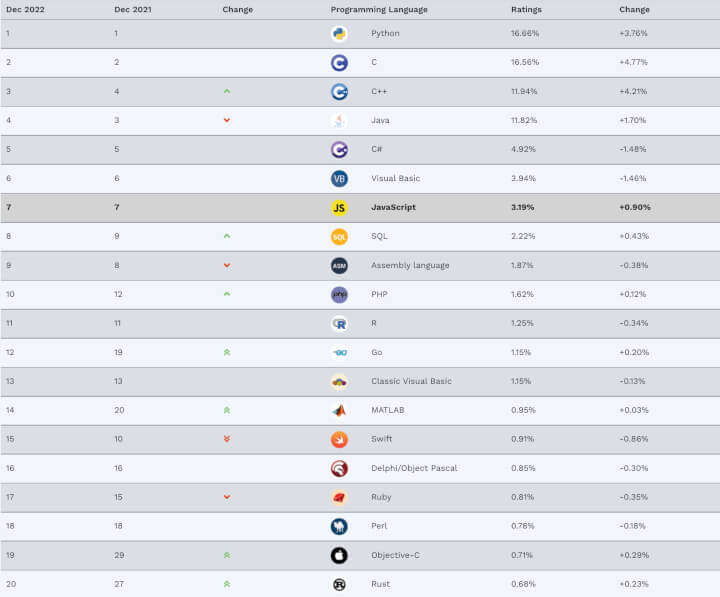Why is Python so popular? One of the main reasons it is popular as a programming language is that it's a great way to learn how to code. It reads almost like plain English and has many features that allow you to write complex tasks very simply. Additionally, there are many applications for which Python is a great option, including data science, AI and machine learning, web development and Internet of Things (IoT) with devices like the Raspberry Pi.
Let’s take a deeper look at why Python is so popular.

History of Python programming language
Python was released in 1991 by Dutchman Guido van Rossum as an interpreted programming language with an emphasis on readability. As an open-source language, it's been used on many large scale projects with great success, including at Google, YouTube, EVE Online and Firaxis Games.
"Python has been an important part of Google since the beginning, and remains so as the system grows and evolves. Today dozens of Google engineers use Python, and we're looking for more people with skills in this language." said Peter Norvig, director of search quality at Google, Inc.
"Python enabled us to create EVE Online, a massive multiplayer game, in record time. The EVE Online server cluster runs over 50,000 simultaneous players in a shared space simulation, most of which is created in Python. The flexibilities of Python have enabled us to quickly improve the game experience based on player feedback" said Hilmar Veigar Petursson of CCP Games.
Regardless of whether you use Python for scripting, data science or web development, today there are many built-in and third-party tools and libraries which will help you write efficient code. All the major platforms support Python and Macs even come with it pre-installed!
Interested in web development?
Learn all about it in our comprehensive (and free) ebook!
Popularity of Python programming language
According to the TIOBE index, which ranks programming languages based on their popularity, has Python ranked in the number 1 slot.

TIOBE index as at December 2022
Furthermore, the PYPL (PopularitY of Programming Language Index) scores Python as the most popular language and also ranks it as the fastest-growing language, based on search engine searches for various programming languages. They say: “Worldwide, Python is the most popular language, Python grew the most in the last 5 years (17.6%).”

Why is Python so popular?
1. It’s one of the best languages when learning to code
If you're new to coding or you're hoping to get someone you know interested in coding, good on you! Secondly, consider making Python your language of choice. It's one of the easiest programming languages to learn, due to the fact that it reads and writes quite a bit like plain English.
In fact, there are many code clubs out in the world that you can join to help teach school kids how to code, and Python is one of the most common tools for this, at least in my experience. From little scripts and games to controlling LEDs and robots, there is a lot you can do to make learning fun. And if you're a kid at heart like me, you'll enjoy the projects as an adult too!
We also have an Introduction to Python course here at GoSkills, so make sure you check that out if you’re looking to get started.
2. Python is heavily used in the Internet of Things
With the rise of the Internet of Things - small low-power devices that are connected to the internet and can run any custom code - Python has risen to the top for a lot of the devices you can buy and tinker with. Devices like the Raspberry Pi are tiny and connect to a multitude of sensors, displays, lights, robots and more, and allow you to write code to communicate between these parts, as well as send and receive data over Bluetooth, the internet and other communication methods.
While not all of these devices support Python, a lot of them do; either a fully-featured version of Python or Micropython: a subset of Python for simpler devices, so you can still take advantage of the simplicity and productivity of Python without needing the full power it normally requires.
3. Python is instrumental in data science and AI
Arguably the areas where you find Python the most are data science, AI and machine learning - a subset of AI. Out of the box, Python comes with a lot of built-in libraries that provide a lot of the functionality a data scientist might need. In addition to that, there are also a great number of robust and popular libraries you can download for Python and use in your projects, such as NumPy, Pandas, matplotlib, and SciPy for math, data manipulation, data visualization and more.
It also can't be underestimated how important Python’s ease of use is in this field. As a scientist, it's likely you didn't sign up to be a programmer, so the fact that Python provides you with the ability to perform advanced calculations with relative ease is really cool. The faster you can get from hypothesis to data analysis, the better.
The other language that's generally associated with data science is R. However, according to the TIOBE Index mentioned above, R’s popularity is dropping and has even fallen out of the TIOBE Top 20 list this year, after having been in the Top 20 for 3 years. So if you're deciding between the two, trends are suggesting Python is the more robust choice.
4. Python is versatile for web development
This wouldn't be an article of mine if I didn't mention my love for web development. As you've seen so far, Python is incredibly versatile and powerful and this extends to the web as well.
When setting up a web server, you might think of Node.js, .NET or Java, but Python is another great contender. While it lacks some of the performance of the other languages and frameworks, it's easy to get something up and running in Python very quickly and to continue being very productive. The developer experience can outweigh the reduced performance, and scaling your system for performance is becoming easier than ever with cloud services like AWS, Azure, Google Cloud etc.
When it comes to frameworks there are two main contenders: Flask and Django. Flask is a more minimalist framework that lets you determine how you want to approach the design of your system, which is great for seasoned developers. Django is a more “batteries-included” framework that provides a fairly rigid structure, which is great for beginners and prototyping where you just want to get something up and running very quickly.
Thinking back on the other applications of Python that we've discussed, keep in mind that these do not have to be mutually exclusive. If you're setting up a website that leverages AI or machine learning, what better language to combine the two?
Brush up on your Python skills
The Monty Python-inspired language has come a long way since it was released in 1991 and is still gaining popularity today. This rise in popularity combined with its versatility makes it a great choice of language to learn, for both beginners and experienced programmers from various backgrounds.
GoSkills is the perfect place to start with the Intro To Python course, which can help you learn the fundamentals of this highly marketable programming language.
And don’t forget to check out our other Development courses and free Development resources.
Thanks for reading!
Learn in-demand skills
Take your career to the next level with GoSkills coding courses
Start free trial



